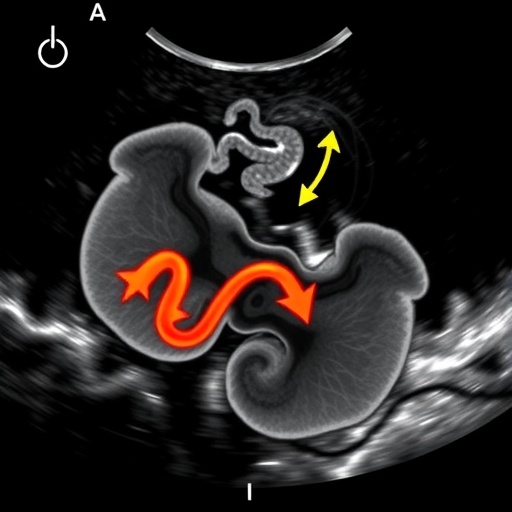In an era where technological advancements are reshaping the landscape of medical diagnostics, recent research has made significant strides in prenatal imaging. A groundbreaking study by Wu et al. has unveiled a promising application of deep learning in the diagnosis of cerebellar hypoplasia through fetal ultrasound. This research highlights the potential of integrating artificial intelligence with traditional imaging methods, paving the way for more accurate and timely interventions for various fetal conditions.
Cerebellar hypoplasia, a condition characterized by underdevelopment of the cerebellum, poses serious challenges in neonatal health. Traditionally, diagnosing such conditions has relied heavily on the expertise of ultrasound technicians and radiologists. However, the introduction of deep learning algorithms offers a novel approach that could augment diagnostic capabilities. By training models to recognize patterns associated with cerebellar structures, this study seeks to enhance the precision of ultrasound evaluations.
The researchers focused on the anatomical complexity of the cerebellum and the surrounding cistern, acknowledging that these structures serve as critical landmarks in fetal imaging. By leveraging this anatomical information, the team was able to refine their deep learning models, substantially improving the AI’s ability to identify signs of cerebellar hypoplasia. This method not only augments the current diagnostic protocols but also addresses the urgency of early detection, which is pivotal in managing the associated risks effectively.
The methodology adopted by Wu et al. involved a comprehensive dataset of prenatal ultrasounds, annotated meticulously to train the deep learning models. The process of selecting relevant images was critical; each label affixed to ultrasound images contributed significantly to the fine-tuning of the algorithm. This meticulous approach ensured that the model was robust enough to generalize findings from diverse imaging scenarios, mirroring the variations encountered in real-world clinical settings.
One of the core advantages of employing deep learning in this context is its ability to process vast amounts of data far more efficiently than conventional methods. As traditional diagnostic methods often depend on subjective interpretation, there exists a latent risk of human error. The deep learning-driven approach, conversely, minimizes this risk by adopting a data-driven perspective, refining its interpretations through continuous learning from new datasets. This development not only enhances diagnostic accuracy but also contributes to the overall efficiency of prenatal care.
Furthermore, the implications of this research extend beyond mere diagnosis; they lay the groundwork for future explorations into automated prenatal healthcare solutions. As the model matures and additional features are incorporated, there is potential for the technology to guide clinicians in decision-making processes regarding the management of pregnancies identified with cerebellar hypoplasia. This could include tailored monitoring protocols, educational resources for parents, and strategies for postnatal care.
The intersection of artificial intelligence and medicine has often sparked discussions surrounding ethics, data privacy, and the role of human practitioners. In the context of this study, the authors emphasize the importance of collaboration between AI systems and healthcare professionals. While deep learning models can enhance diagnostic accuracy, the contextual understanding and empathy provided by human clinicians remain irreplaceable. This synergy could transform prenatal care, ultimately improving outcomes for both mothers and infants.
Moreover, this pioneering research serves as a beacon for further studies aimed at diagnosing other congenital conditions. The methodologies developed in this study could be replicated or adapted to detect a variety of fetal abnormalities, thus broadening the horizons of prenatal diagnostics. The researchers forecast that with continued advancements in imaging technology and AI development, the future of prenatal screening will compromise fewer resources while yielding significant gains in accuracy and reliability.
As the global community becomes increasingly aware of the implications of prenatal health, there is an urgent demand for innovative solutions. The findings of Wu et al. not only address this need but also contribute substantially to the dialogue surrounding the future role of technology in healthcare. The inevitability of such innovations necessitates continuous discussions on the implementation and regulation of AI technologies in clinical settings.
Importantly, the study’s advancement poses questions regarding accessibility and democratization of advanced prenatal diagnostics. If such AI-driven diagnostic tools prove effective, there must be dedicated efforts to ensure that these technologies are accessible to diverse populations, especially in under-resourced areas. The integration of these tools into conventional medical practices could significantly alter the landscape of prenatal care and its accessibility worldwide.
As this study reverberates through the medical community, it is imperative for clinicians, researchers, and policymakers to engage in critical discussions surrounding the transformative impacts of AI in healthcare. The potential for enhancing clinical outcomes is tremendous, yet this necessitates a careful balance of innovation with ethical considerations and practical implementations.
In conclusion, Wu et al.’s research marks a significant leap in prenatal diagnostics, merging deep learning with traditional imaging techniques. The potential to accurately diagnose cerebellar hypoplasia paves the way for future technological advancements aimed at fetal health. As the field progresses, continued exploration and adaptation of these technologies will inevitably contribute to improved outcomes for expectant mothers and their children alike.
Subject of Research: Prenatal diagnosis of cerebellar hypoplasia using deep learning and ultrasound imaging.
Article Title: Prenatal diagnosis of cerebellar hypoplasia in fetal ultrasound using deep learning under the constraint of the anatomical structures of the cerebellum and cistern.
Article References:
Wu, X., Liu, F., Xu, G. et al. Prenatal diagnosis of cerebellar hypoplasia in fetal ultrasound using deep learning under the constraint of the anatomical structures of the cerebellum and cistern. Pediatr Radiol (2025). https://doi.org/10.1007/s00247-025-06376-2
Image Credits: AI Generated
DOI: https://doi.org/10.1007/s00247-025-06376-2
Keywords: prenatal diagnostics, cerebellar hypoplasia, deep learning, ultrasound imaging, artificial intelligence.




